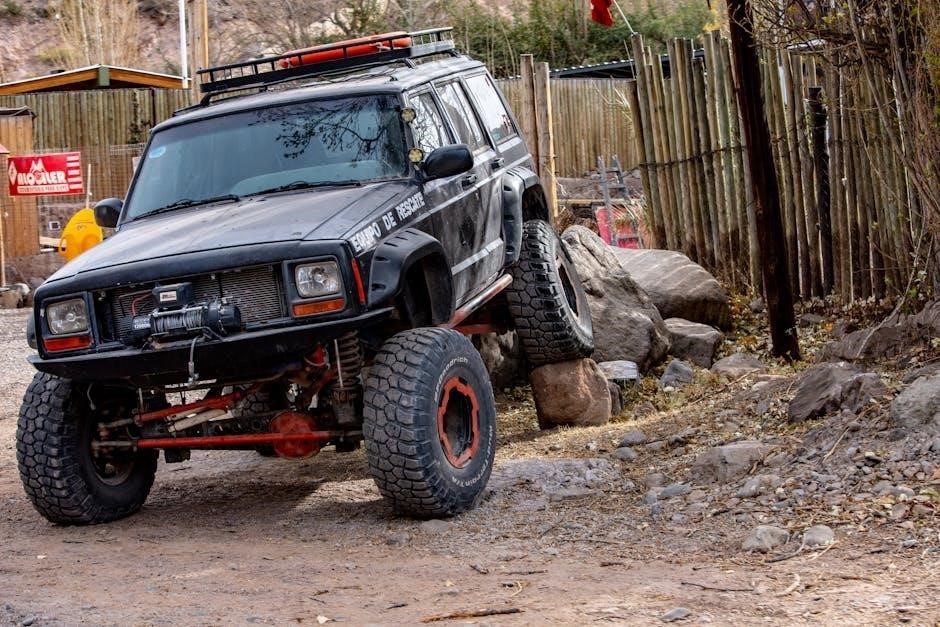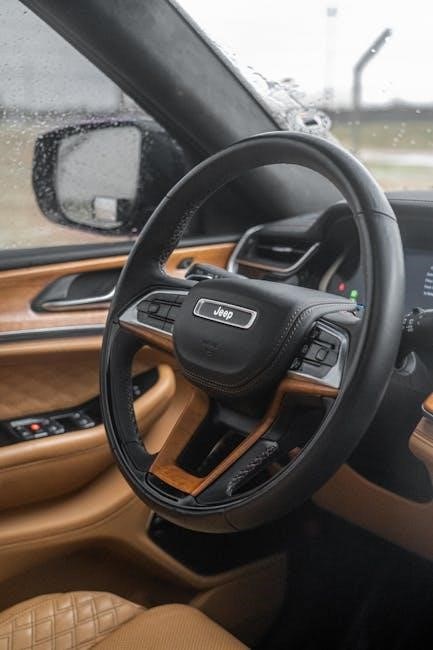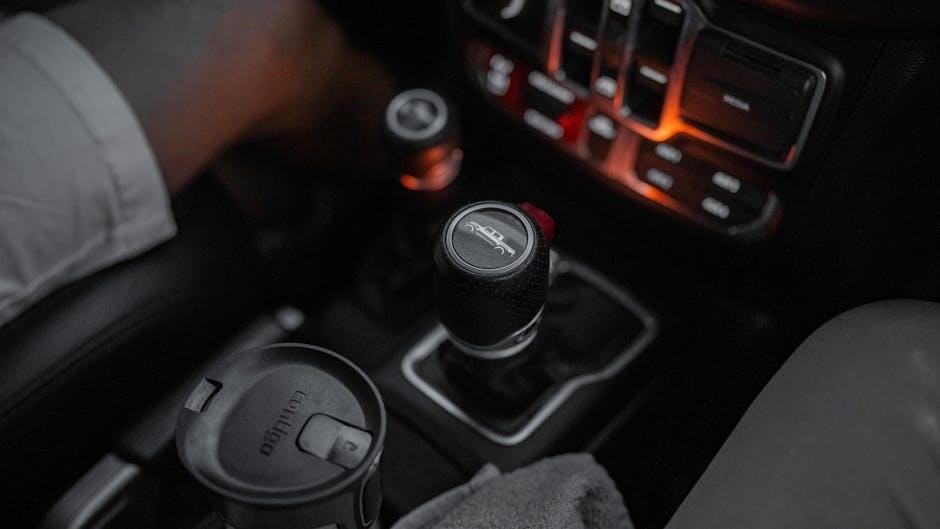The Jeep Cherokee manual is a comprehensive guide detailing operation, maintenance, and troubleshooting. It includes essential information for optimal vehicle performance and safety, ensuring a smooth driving experience.
Overview of the Manual’s Purpose and Structure
The Jeep Cherokee manual is designed to provide owners with detailed insights into vehicle operation, maintenance, and troubleshooting. Structured for easy navigation, it includes sections on features, specifications, and guidelines for optimal performance. The manual begins with introductory information, followed by maintenance schedules and troubleshooting tips. It also covers advanced systems like 4WD and safety features. Organized logically, the manual ensures users can quickly find relevant information. Its purpose is to empower owners with knowledge for proper vehicle care and operation, ensuring safety and longevity. Whether addressing routine maintenance or complex repairs, the manual serves as an indispensable reference guide.
Importance of Reading the Manual for Vehicle Maintenance
Reading the Jeep Cherokee manual is crucial for understanding proper vehicle maintenance. It provides detailed schedules for oil changes, tire rotations, and fluid checks, ensuring optimal performance. The manual highlights guidelines for synthetic and non-synthetic oil usage, helping owners make informed decisions. By following the manual, drivers can identify early signs of potential issues, preventing costly repairs. It also outlines safety precautions and best practices, reducing the risk of accidents. Regular maintenance, as per the manual, extends the vehicle’s lifespan and maintains its value. Familiarizing yourself with the manual ensures a safer, more efficient, and enjoyable driving experience.

Maintenance Schedule and Recommendations
The Jeep Cherokee manual outlines essential maintenance intervals, including oil changes, tire rotations, and fluid checks, ensuring optimal vehicle performance and longevity. Synthetic oil is recommended for extended mileage.
Oil Change Intervals and Synthetic vs. Non-Synthetic Oil
The Jeep Cherokee manual recommends oil changes at specific intervals to maintain engine health. Synthetic oil should be changed every 7,500 to 10,000 miles, offering better performance in extreme temperatures and extended durability. Non-synthetic oil requires more frequent changes, typically every 5,000 miles. Using synthetic oil is advised for its superior lubrication properties and ability to withstand harsh driving conditions. Always follow the manual’s guidelines to ensure optimal engine performance and longevity. Proper oil selection and regular changes are crucial for maintaining your Jeep Cherokee’s reliability and preventing premature wear on engine components.
Tire Rotation and Pressure Guidelines
Regular tire rotation and proper pressure maintenance are essential for extending the life of your Jeep Cherokee’s tires. The manual recommends rotating tires every 8,000 to 10,000 miles to ensure even tread wear and optimal performance. Check tire pressure monthly, before long trips, and when temperatures change, as pressure can fluctuate. Use the Tire Pressure Monitoring System (TPMS) to ensure pressures match the specifications listed in the manual. Properly inflated tires improve fuel efficiency, handling, and safety. Always refer to the manual for accurate pressure values and rotation patterns tailored to your vehicle’s make and model year.
Fluid Check and Replacement Schedule
Regular fluid checks are crucial for maintaining your Jeep Cherokee’s performance and longevity. The manual recommends checking engine oil, coolant, transmission, and brake fluids regularly. Engine oil should be replaced every 5,000 to 7,500 miles, while coolant and transmission fluid typically need replacement every 30,000 to 60,000 miles. Brake fluid should be inspected annually and replaced as needed. Always use fluids that meet the specifications outlined in the manual to ensure compatibility and optimal performance. Neglecting fluid maintenance can lead to premature wear and potential engine damage. Consult your manual or a certified mechanic for precise schedules and guidelines.

Common Issues and Troubleshooting
The Jeep Cherokee manual addresses common issues like error messages and auto start/stop malfunctions, offering troubleshooting steps to resolve problems efficiently and ensure proper vehicle function.
Understanding Error Messages (e.g., “Shift to Park”)
Error messages like “Shift to Park” indicate issues with the vehicle’s systems. This message typically appears when the transmission is not properly engaged in park, preventing safe ignition shutdown. According to the manual, drivers should stop the vehicle, ensure it is securely in park, and restart the engine. Persistent errors may signal deeper mechanical problems, requiring professional inspection. The manual advises consulting the troubleshooting section for detailed instructions and ensuring all safety protocols are followed to avoid potential damage or safety hazards.
Auto Start/Stop System Malfunctions
The Auto Start/Stop system in your Jeep Cherokee may malfunction, indicated by an illuminated warning light with an exclamation mark. This system automatically shuts off the engine during stops to save fuel but may fail to restart due to battery issues, faulty sensors, or software glitches. If the system malfunctions, the engine may not turn off or restart as expected. To address this, restart the engine, ensure the battery is fully charged, and check for any error messages. If the problem persists, consult the manual or visit an authorized dealer for diagnostic assistance to restore proper system function.
Known Problems with the Jeep Cherokee
Some Jeep Cherokee models, particularly older ones, have known issues such as transmission problems, electrical system malfunctions, and engine faults. The 2014-2016 models, for instance, experienced issues with the 9-speed automatic transmission, leading to rough shifting and unexpected disengagement. Additionally, some drivers reported problems with the auto start/stop system and battery drain. The manual recommends regular maintenance to mitigate these issues, such as updating software, replacing faulty sensors, and ensuring proper battery health. Persistent problems should be addressed by authorized dealers to prevent further complications and ensure reliable performance.
Features and Capabilities of the Jeep Cherokee
The Jeep Cherokee combines advanced LED optics, modern design, and robust off-road capabilities. It offers a comfortable interior with cutting-edge technology, ensuring versatility for both city and adventure driving.
Towing Capacity and Off-Road Performance
The Jeep Cherokee offers impressive towing capacity, up to 4,500 pounds, making it suitable for hauling trailers or boats. Its off-road performance is enhanced by a robust 4WD system, featuring modes like Rock for challenging terrains; With excellent ground clearance and approach/departure angles, it navigates rugged trails effortlessly. The Cherokee also excels in water fording, capable of handling up to 19 inches of water, ensuring reliability in extreme conditions. These features make it a versatile choice for both urban commuting and adventurous off-road escapades, combining power and agility seamlessly.
Advanced LED Optics and Modern Design
The Jeep Cherokee features advanced LED optics, providing superior illumination and a sleek appearance. Its modern design includes a refined exterior with a longer and broader stance, enhancing both aesthetics and functionality. LED lighting improves visibility while driving and offers a contemporary look. The interior boasts a spacious cabin with premium materials, blending comfort and style. The design updates ensure the Cherokee stands out, maintaining its iconic appeal while embracing modern trends for a polished and sophisticated vehicle. These enhancements contribute to a driving experience that balances practicality with cutting-edge visuals and technology.
Interior Features and Technology
The Jeep Cherokee offers a well-appointed interior with modern technology designed for comfort and convenience. The Uconnect system provides an intuitive touchscreen interface, allowing easy access to navigation, entertainment, and vehicle settings. Bluetooth connectivity and voice command functionality enhance hands-free control, while premium audio systems deliver high-quality sound. The cabin features ergonomic seating, ample cargo space, and customizable storage solutions. Advanced safety features, such as a digital instrument cluster and driver-assistance systems, are also available. These interior upgrades ensure a blend of practicality, comfort, and innovation, making the Cherokee a versatile choice for both daily driving and off-road adventures.

Model Year Differences and Reliability
Reliability varies across Jeep Cherokee model years, with some offering excellent durability and others facing known issues like transmission problems and electrical faults requiring costly repairs.
Best and Worst Model Years
The Jeep Cherokee has seen varying reliability across its model years. The 2016 and 2022 models are often praised for their durability and minimal issues. However, the 2014 and 2015 models faced criticism due to transmission problems and electrical faults. Additionally, certain years within the fifth generation have reported concerns with the auto stop/start system and infotainment malfunctions. It’s crucial for potential buyers to research specific model years and their common issues to make an informed decision. Reliability reports and owner feedback can provide valuable insights into selecting a dependable Jeep Cherokee.
Reliability Concerns and Common Repairs
The Jeep Cherokee has faced reliability concerns, particularly with transmission issues and electrical faults in earlier models. The auto start/stop system has also been known to malfunction, requiring repairs. Additionally, some owners have reported problems with the infotainment system and powertrain. Regular maintenance, as outlined in the manual, can help mitigate these issues. Addressing recalls and software updates promptly is crucial for long-term reliability. While newer models have shown improvement, it’s essential for owners to stay proactive with servicing to avoid costly repairs and ensure optimal performance.
Generational Changes in the Jeep Cherokee
The Jeep Cherokee has undergone significant generational changes since its introduction in 1990. The XJ (1984–2001) and KJ (2002–2007) models laid the foundation, with the KL generation (2014–present) introducing modern advancements. Each generation brought improvements in design, technology, and performance, with a focus on enhancing both on-road comfort and off-road capabilities; The 2022 model featured updated LED optics and a longer wheelbase, maintaining its iconic style while adopting contemporary aesthetics. These changes reflect Jeep’s commitment to innovation while preserving the Cherokee’s legendary versatility and durability, ensuring it remains a standout in its class for reliability and capability.

Off-Road Capabilities and Tips
The Jeep Cherokee excels off-road with its advanced 4WD systems, high ground clearance, and articulation. Always consult the manual for specific mode recommendations and safety guidelines.
Understanding 4WD Systems
The Jeep Cherokee features advanced 4WD systems designed for optimal traction and control. The manual details three modes: 4×2 (rear-wheel drive), 4×4 Lock (equal torque distribution), and 4×4 Auto (automatic engagement).
For off-road conditions, the Selec-Terrain system offers customizable settings like Sand, Mud, and Rock modes. Always refer to the manual for proper mode selection and operation.
Understanding these systems ensures improved performance and safety, whether on paved roads or challenging terrains.
Ground Clearance and Articulation
The Jeep Cherokee’s ground clearance is optimized for off-road performance, allowing it to navigate uneven terrain with ease.
The manual highlights the importance of maintaining proper suspension articulation to ensure all wheels stay in contact with the ground.
Higher trim levels, such as the Trailhawk, offer increased clearance and advanced suspension systems for enhanced articulation.
This feature improves stability and traction, making the Cherokee capable of handling challenging off-road conditions effectively.
Water Fording and Maneuverability
The Jeep Cherokee manual provides detailed guidelines for water fording, ensuring safe navigation through water crossings.
It specifies maximum water depth limits to prevent engine damage and electrical system malfunctions.
The Cherokee’s compact design and responsive steering enhance maneuverability, making it agile in tight off-road spaces.
Advanced four-wheel-drive systems further improve control during water crossings, maintaining traction and stability.
Proper techniques, such as steady speed and avoiding sudden acceleration, are emphasized to safely traverse water obstacles.

Resources for Further Assistance
Download the Jeep Cherokee manual in PDF for free online or visit authorized dealers for expert guidance. Community forums also offer valuable insights and user experiences.
Online PDF Manuals and Downloads
Accessing the Jeep Cherokee manual is straightforward with online resources offering free PDF downloads. Websites like Manual Directory provide comprehensive guides for various model years, from 2014 to 2023. These manuals include detailed instructions for maintenance, troubleshooting, and feature explanations. Users can view the documents directly or download them for offline use. Additionally, authorized dealer websites often host official manuals, ensuring authenticity and relevance. The PDF format allows for easy navigation, printing, and reference. This resource is invaluable for owners seeking to understand their vehicle better, ensuring proper care and optimal performance of their Jeep Cherokee.
Authorized Dealer Recommendations
Consulting an authorized Jeep dealer ensures expert service tailored to your Cherokee. Their factory-trained technicians use genuine parts and adhere to manufacturer guidelines, guaranteeing reliable repairs. Dealerships offer comprehensive support, from routine maintenance to complex diagnostics. They provide accurate troubleshooting and solutions, ensuring your vehicle operates at peak performance. Additionally, authorized dealers can interpret error messages and address system malfunctions effectively. Visiting a dealer also grants access to exclusive resources, such as detailed service histories and personalized advice. This expertise ensures your Jeep Cherokee remains in optimal condition, maintaining its safety, efficiency, and longevity.
Community Forums and User Guides
Community forums and user guides provide valuable insights and real-world experiences for Jeep Cherokee owners. These platforms allow drivers to share tips, troubleshooting solutions, and DIY maintenance advice. Forum discussions often highlight common issues, such as error messages or system malfunctions, and offer practical fixes. User guides, shared by experienced owners, can complement the official manual by providing hands-on perspectives. While these resources are helpful, always cross-reference with the official manual or consult a professional for critical repairs. Engaging with these communities fosters a sense of support and knowledge-sharing, empowering owners to maximize their vehicle’s performance and longevity.